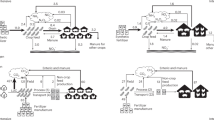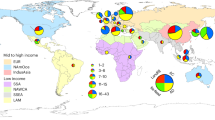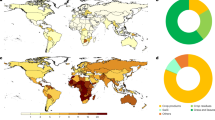Abstract
Upcycling food waste and food processing by-products as animal feed could reduce livestock-related emissions, but rebound effects, where lower feed costs lead to livestock expansion, may diminish these benefits. Here, using an integrated environmental–economic model, we assess the impacts of this upcycling in China’s monogastric livestock production. We find that upcycling increases monogastric livestock production by 23–36% and raises total acidification emissions in China by 2.5–4.0%, while domestically total greenhouse gas emissions decrease by 0.5–1.4% through less waste sent to landfill and incinerators and a contraction in non-food production. This upcycling enhances food security and has substantial knock-on effects beyond the agricultural sectors, through influencing sectoral employment, gross domestic product and household welfare. Although emission taxes could absorb the rebound effects on emissions, they may also negatively impact food security and shift emissions abroad, depending on tax levels.
This is a preview of subscription content, access via your institution
Access options
Access Nature and 54 other Nature Portfolio journals
Get Nature+, our best-value online-access subscription
$32.99 / 30 days
cancel any time
Subscribe to this journal
Receive 12 digital issues and online access to articles
$119.00 per year
only $9.92 per issue
Buy this article
- Purchase on SpringerLink
- Instant access to full article PDF
Prices may be subject to local taxes which are calculated during checkout





Similar content being viewed by others
Data availability
The data and parameters that support the economic model in this study are available from the GTAP version 10 database (https://www.gtap.agecon.purdue.edu/databases/v10/). The other data that support splitting agricultural (six crop types and two livestock categories) and non-agricultural (compound feed, food processing by-products, processed food, fertilizers, food waste treatment and non-food) sectors from the original database GTAP 10 are publicly available at FAOSTAT (http://www.fao.org/faostat/en/#data) and the UN Comtrade Database (https://comtrade.un.org/data). All other data supporting the findings of this study, such as the production of crops, livestock and fertilizers, the utilization of food waste and food processing by-products, prices of food waste recycling and collection services, and emissions, are available within the article and its Supplementary Information files or are available from the corresponding authors upon reasonable request. Source data are provided with this paper.
Code availability
The GAMS code for reproducing the results of this study is available from the corresponding authors upon reasonable request.
References
Springmann, M. et al. Options for keeping the food system within environmental limits. Nature 562, 519–525 (2018).
Bai, Z. et al. China’s livestock transition: driving forces, impacts, and consequences. Sci. Adv. 4, eaar8534 (2018).
FAOSTAT (FAO, 2022); http://www.fao.org/faostat/en/#data
Richardson, K. et al. Earth beyond six of nine planetary boundaries. Sci. Adv. 9, eadh2458 (2023).
Steinfeld, H. et al. Livestock’s Long Shadow: Environmental Issues and Options (FAO, 2006).
Herrero, M. et al. Greenhouse gas mitigation potentials in the livestock sector. Nat. Clim. Change 6, 452–461 (2016).
Uwizeye, A. et al. Nitrogen emissions along global livestock supply chains. Nat. Food 1, 437–446 (2020).
Hamilton, H. A. et al. Trade and the role of non-food commodities for global eutrophication. Nat. Sustain. 1, 314–321 (2018).
Gustavsson, J., Cederberg, C., Sonesson, U., van Otterdijk, R. & Meybeck, A. Global Food Losses and Food Waste (FAO Rome, 2011).
Driven to waste: the global impact of food loss and waste on farms. WWF https://wwf.panda.org/discover/our_focus/food_practice/food_loss_and_waste/driven_to_waste_global_food_loss_on_farms/ (accessed 1 December 2021).
Wang, Y. et al. Evidence of animal productivity outcomes when fed diets including food waste: a systematic review of global primary data. Resour. Conserv. Recycl. 203, 107411 (2024).
van Zanten, H. H. E. et al. Defining a land boundary for sustainable livestock consumption. Glob. Change Biol. 24, 4185–4194 (2018).
Fang, Q. et al. Low-opportunity-cost feed can reduce land-use-related environmental impacts by about one-third in China. Nat. Food 4, 677–685 (2023).
van Hal, O. et al. Upcycling food leftovers and grass resources through livestock: impact of livestock system and productivity. J. Clean. Prod. 219, 485–496 (2019).
Transforming Our World: The 2030 Agenda for Sustainable Development (UN, 2015); https://sdgs.un.org/2030agenda
Berkhout, P. H. G., Muskens, J. C. & W. Velthuijsen, J. Defining the rebound effect. Energy Policy 28, 425–432 (2000).
Schipper, L. & Grubb, M. On the rebound? Feedback between energy intensities and energy uses in IEA countries. Energy Policy 28, 367–388 (2000).
Sorrell, S., Dimitropoulos, J. & Sommerville, M. Empirical estimates of the direct rebound effect: a review. Energy Policy 37, 1356–1371 (2009).
Gatto, A., Kuiper, M. & van Meijl, H. Economic, social and environmental spillovers decrease the benefits of a global dietary shift. Nat. Food 4, 496–507 (2023).
Hegwood, M. et al. Rebound effects could offset more than half of avoided food loss and waste. Nat. Food 4, 585–595 (2023).
Hasegawa, T. et al. Risk of increased food insecurity under stringent global climate change mitigation policy. Nat. Clim. Change 8, 699–703 (2018).
Peña-Lévano, L. M., Taheripour, F. & Tyner, W. E. Climate change interactions with agriculture, forestry sequestration, and food security. Environ. Resour. Econ. 74, 653–675 (2019).
Jiang, H.-D., Liu, L.-J. & Deng, H.-M. Co-benefit comparison of carbon tax, sulfur tax and nitrogen tax: the case of China. Sustainable Prod. Consumption 29, 239–248 (2022).
Long, W., Zhu, X., Weikard, H.-P., Oenema, O. & Hou, Y. Exploring sustainable food system transformation options in China: an integrated environmental-economic modelling approach based on the applied general equilibrium framework. Sustainable Prod. Consumption 51, 42–54 (2024).
Gerlagh, R. & Kuik, O. Spill or leak? Carbon leakage with international technology spillovers: a CGE analysis. Energy Econ. 45, 381–388 (2014).
The Paris Agreement (UNFCCC, 2015).
Xue, L. et al. China’s food loss and waste embodies increasing environmental impacts. Nat. Food 2, 519–528 (2021).
Guiding Opinions on Promoting Loss Reduction and Efficiency Increase in Agricultural Product Processing (Ministry of Agriculture and Rural Affairs, 2020); http://www.moa.gov.cn/govpublic/XZQYJ/202012/t20201225_6358876.htm
Technical Solution for Reducing Corn and Soybean Meal in Pig and Chicken Feed (Ministry of Agriculture and Rural Affairs; 2021); http://www.moa.gov.cn/gk/nszd_1/2021/202104/t20210421_6366304.htm
Notice of the State Council on Issuing the Comprehensive Work Plan for Energy Conservation and Emission Reduction during the 14th Five-Year Plan (State Council of the People’s Republic of China, 2022); https://www.gov.cn/xinwen/2022-01/24/content_5670214.htm
Mathivanan, R., Selvaraj, P. & Nanjappan, K. Feeding of fermented soybean meal on broiler performance. Int. J. Poultry Sci. 5, 868–872 (2006).
No. 1774/2002 of the European Parliament and of the Council of 3 October 2002 Laying Down Health Rules Concerning Animal Byproducts Not Intended For Human Consumption (European Commission, 2002).
Dou, Z., Toth, J. D. & Westendorf, M. L. Food waste for livestock feeding: Feasibility, safety, and sustainability implications. Global Food Secur. 17, 154–161 (2018).
Bai, Z. et al. Investing in mini-livestock production for food security and carbon neutrality in China. Proc. Natl Acad. Sci. USA 120, e2304826120 (2023).
Zhou, M.-H., Shen, S.-L., Xu, Y.-S. & Zhou, A.-N. New policy and implementation of municipal solid waste classification in Shanghai, China. Int. J. Environ. Res. Public Health 16, 3099 (2019).
Three-Year Action Plan for Reducing and Replacing Feed Soybean Meal (Ministry of Agriculture and Rural Affairs, 2023); https://www.gov.cn/zhengce/zhengceku/2023-04/14/content_5751409.htm
Tong, B. et al. Lower pork consumption and technological change in feed production can reduce the pork supply chain environmental footprint in China. Nat. Food 4, 74–83 (2022).
Wang, X. et al. Assessing the impacts of technological change on food security and climate change mitigation in China’s agriculture and land-use sectors. Environ. Impact Assess. Rev. 107, 107550 (2024).
Chepeliev, M. Incorporating Nutritional Accounts to the GTAP Data Base. J. Global Econ. Anal. 7, 1–43 (2022).
GTAP Database Version 10 (GTAP, 2014); http://www.gtap.agecon.purdue.edu/
General Algebraic Modeling System (GAMS, 2022); https://www.gams.com/
Shurson, G. C. ‘What a waste’—can we improve sustainability of food animal production systems by recycling food waste streams into animal feed in an era of health, climate, and economic crises? Sustainability 12, 7071 (2020).
Gustafsson, J., Cederberg, C., Sonesson, U. & Emanuelsson, A. The Methodology of the FAO Study: Global Food Losses and Food Waste—Extent, Causes and Prevention FAO, 2011 (SIK Institutet för livsmedel och bioteknik, 2013).
Technical Conversion Factors for Agricultural Commodities (FAO, 1997).
Peterson, E. B. GTAP-M: A GTAP Model and Data Base That Incorporates Domestic Margins (GTAP Technical Paper, 2006).
Laborde, D., Mamun, A., Martin, W., Piñeiro, V. & Vos, R. Agricultural subsidies and global greenhouse gas emissions. Nat. Commun. 12, 2601 (2021).
Goedkoop, M. et al. ReCiPe 2008: A Life Cycle Impact Assessment Method Which Comprises Harmonised Category Indicators at the Midpoint and the Endpoint Level (2009).
Rome Declaration on World Food Security and World Food Summit Plan of Action (FAO, 1996).
Methodology for the Measurement of Food Deprivation: Updating the Minimum Dietary Energy Requirements (FAO, 2008).
Cialani, C. & Mortazavi, R. The cost of urban waste management: an empirical analysis of recycling patterns in Italy. Front. Sustainable Cities 2, 8 (2020).
Acknowledgements
We thank conference participants at the 29th Annual Conference of European Association of Environmental and Resource Economists (EAERE), the III Economy for The Common Good International Conference (ECGIC), and the 4th Dutch Environmental and Resource Economics (DEARE) Day workshop for helpful comments and discussions. We thank Q. Fang for sharing data on food waste and food processing by-products in China, which is essential to this study. We acknowledge financial support from the National Natural Science Foundation of China [no. 32272814] (Y.H.), the High-level Team Project of China Agricultural University (Y.H.), and the Agriculture Green Development Program sponsored by China Scholarship Council [no. 201913043] (W.L.). Artificial Intelligence (in our case, ChatGPT) has been used to polish the English writing of paragraphs in this paper. After using this tool/service, we reviewed and edited the content as needed and took full responsibility for the content of the publication.
Author information
Authors and Affiliations
Contributions
W.L., X.Z., H.-P.W., and Y.H. designed the research. W.L. and X.Z. developed the model. W.L. ran the model and performed the analysis. W.L. collected and analysed data. W.L. wrote the paper with contributions from X.Z., H.-P.W., O.O., and Y.H. All authors contributed to the interpretation of the results and commented on the paper.
Corresponding authors
Ethics declarations
Competing interests
The authors declare no competing interests.
Peer review
Peer review information
Nature Food thanks Yanxian Li and the other, anonymous, reviewer(s) for their contribution to the peer review of this work.
Additional information
Publisher’s note Springer Nature remains neutral with regard to jurisdictional claims in published maps and institutional affiliations.
Supplementary information
Supplementary Information
Supplementary Methods, Results, Discussion, Figs. 1–22, Tables 1–20, References and Appendix tables 1–10.
Source data
Source Data Fig. 2
Statistical source data.
Source Data Fig. 3
Statistical source data.
Source Data Fig. 4
Statistical source data.
Source Data Fig. 5
Statistical source data.
Rights and permissions
Springer Nature or its licensor (e.g. a society or other partner) holds exclusive rights to this article under a publishing agreement with the author(s) or other rightsholder(s); author self-archiving of the accepted manuscript version of this article is solely governed by the terms of such publishing agreement and applicable law.
About this article
Cite this article
Long, W., Zhu, X., Weikard, HP. et al. Rebound effects may undermine the benefits of upcycling food waste and food processing by-products as animal feed in China. Nat Food 6, 881–891 (2025). https://doi.org/10.1038/s43016-025-01219-7
Received:
Accepted:
Published:
Issue date:
DOI: https://doi.org/10.1038/s43016-025-01219-7



